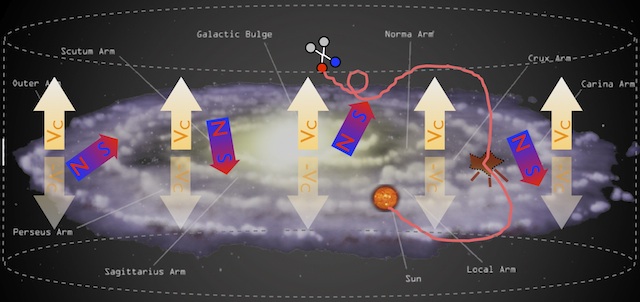
Cookbook for Dark Matter Indirect Detection
 Marco Cirelli and his collaborators (mostly based at CERN, in Estonia and in Italy) had published back in 2010 a complete set of numerical products for Dark Matter Indirect Detection. This work is increasingly used by the community and it is becoming, for some aspects, the state-of-the-art set of tools for this domain.
Marco Cirelli and his collaborators (mostly based at CERN, in Estonia and in Italy) had published back in 2010 a complete set of numerical products for Dark Matter Indirect Detection. This work is increasingly used by the community and it is becoming, for some aspects, the state-of-the-art set of tools for this domain.
Since several decades, cosmological and astrophysical evidence accumulate on the existence of Dark Matter (DM), thanks to its gravitational influence at different scales, showing that it constitutes 80% of the matter in the Universe. On the other hand, an explicit (non- gravitational) manifestation of DM is yet to be identified as its nature is as elusive as ever. One of the most promising approaches to solve this mystery is Indirect Detection, which aims to unravel the possible excess in cosmic rays produced by the annihilations or decay of DM particles in the Galaxy or beyond.
This work computes the energy spectra of electrons and positrons, antiprotons, antideuterium, gamma rays, neutrinos and antineutrinos from DM annihilations or decays in the Galaxy. It also provides the propagation functions for charged particles in the galactic halo, the energy spectra of charged particles at the location of the Earth, the gamma ray fluxes from Inverse Compton scattering in the galactic halo and finally the spectra of extragalactic gamma rays. Most of these results employ improved computational techniques and generalize results previously available.
One concrete achievement is that the community has now at its disposal a suite of results (publicly available in numerical form on a website) which can make possible the analysis of signals that might appear in the data (e.g. the current PAMELA excess in positron fluxes, or future possible results from the Fermi telescope in gamma rays, or the upcoming results from AMS-02 on the International Space Station…). At the same time they can be used to produce predictions for other channels, in a full multi-messenger approach. The work is regularly updated and improved.
Reference:
M. Cirelli, G. Corcella, A. Hektor, G. Hutsi, M. Kadastik, P. Panci, M. Raidal, F. Sala, A. Strumia,
“PPPC 4 DM ID: A Poor Particle Physicist Cookbook for Dark Matter Indirect Detection”,
JCAP 1103 (2011) 051, arXiv:1012.4515 [hep-ph]
F. David, 2013-03-07 00:00:00
